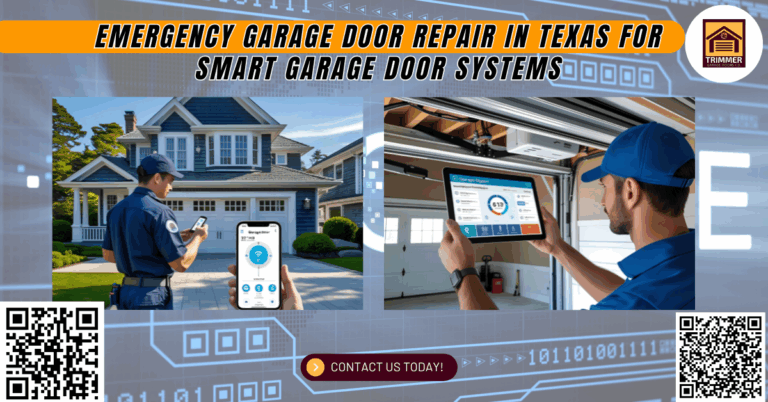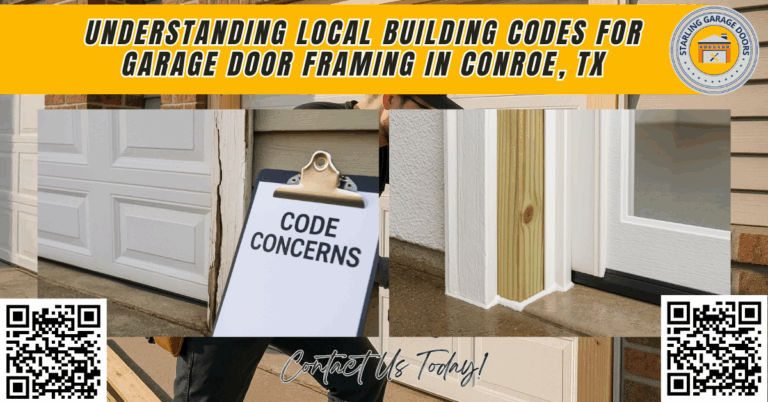When One Cable Breaks, Everything Stops
It was a busy Monday morning when a homeowner in Killeen called our team at Trimmer Garage Doors Co. His garage door had suddenly refused to open. He was in a rush to get to work, and his vehicle was stuck inside. Upon arrival, our technician discovered that one of the garage door cables had snapped. The garage door opener was trying its best to function, but the garage door system was out of alignment. Thankfully, the garage door sensors detected the misalignment and prevented the door from closing further, avoiding what could have been a major accident or injury.
This story is not unusual. Every year, thousands of homeowners across the country experience similar garage door problems, often due to worn or broken cables. According to data from the Door and Access Systems Manufacturers Association (DASMA), garage door cables and springs are among the top reasons for garage door failure, second only to opener malfunctions and misaligned garage door sensors.
Although many people think the garage door opener does all the work, the truth is that the entire garage door system, including springs, rollers, cables, sensors, and the opener unit, must work together like parts of a well-oiled machine. One weak link, such as a frayed cable, can cause significant disruptions and lead to costly repairs. Understanding the essential role of garage door cables in this system is the first step toward keeping your home safe and your garage functioning efficiently.
Understanding Garage Door Cables and How They Work
Garage door cables are one of the most important parts of any garage door system. These steel cables are typically made from several strands of tightly wound galvanized steel, giving them the strength and flexibility needed to lift and lower heavy garage doors. These cables work with the spring system to manage the door’s weight and ensure smooth and controlled operation.
There are two primary types of garage door cables: torsion spring cables and extension spring cables. In a torsion system, the cables wind around a drum located at the top of the garage door as the door opens. In an extension system, the cables stretch along with the springs on either side of the door and contract when the door closes.
Without these cables, the springs alone could not handle the door’s movement. Cables guide the motion of the garage door, prevent it from slamming shut, and ensure that it rises and lowers evenly on both sides. In essence, they keep the garage door aligned, balanced, and safe to operate.
The Role Garage Door Cables Play in Safety and Functionality
Garage door cables are not just mechanical parts. They are crucial to garage door safety. These cables act as a safety net in case one of the garage door springs breaks. For example, if a torsion spring snaps, the cable helps hold the garage door in place, preventing it from crashing to the ground. This feature is especially important in heavy residential or commercial garage doors, where a falling door could cause serious damage or even injury.
Cables also help reduce wear and tear on the garage door opener. A balanced garage door requires less power to move. When the cables are in good condition, the opener unit can operate efficiently, extending its lifespan. A malfunctioning or frayed cable forces the opener to work harder, which can lead to overheating, increased energy usage, and eventual failure.
In summary, garage door cables are vital to both the performance and safety of your garage door system. When installed and maintained properly, they allow for consistent operation, reliable sensor performance, and peace of mind for homeowners and business owners alike.
How Garage Door Cables Interact with Garage Door Sensors
Garage door sensors, particularly photoelectric sensors, play an essential role in modern garage door safety. These sensors are located near the bottom of the garage door, one on each side, and they project an invisible infrared beam across the threshold. If something interrupts this beam, such as a child, pet, or object, the garage door reverses or stops closing, preventing injury or property damage.
So, how are garage door cables connected to this safety feature? When garage door cables become worn or misaligned, they can affect the overall movement and alignment of the door. An uneven or sagging garage door may block the sensor beam or cause false triggers. In some cases, the garage door sensor may think something is in the way and prevent the door from closing at all.
This interaction between cables and sensors highlights the importance of regular garage door maintenance. If you notice that your garage door sensors are not functioning correctly, or if the door doesn’t close smoothly, one of the first things a professional garage door technician will inspect is the condition of the cables. Even the best garage door openers and most sensitive safety sensors cannot work properly if the door itself is out of alignment due to cable damage.
Signs Your Garage Door Cables May Be Damaged
There are several clear warning signs that your garage door cables may be in trouble. Catching these issues early can prevent more serious problems and reduce the risk of injury. Here are a few things to watch out for:
- Frayed or rusted cables: If the cables near the bottom of your garage door look worn, rusted, or are starting to unravel, they need to be replaced immediately.
- Uneven door movement: If your garage door looks crooked when opening or closing, or if one side rises faster than the other, this often indicates a cable problem.
- Loud snapping sounds: A sudden bang or pop during operation could mean a cable or spring has snapped. This can be dangerous, so stop using the door and call a professional immediately.
- Slack cables: If you notice cables hanging loosely or not under tension, it’s a sign that the garage door system is no longer functioning properly.
- Frequent sensor interruptions: If the garage door sensors are constantly preventing the door from closing, and there’s no object blocking the beam, cable misalignment may be to blame.
Recognizing these symptoms and contacting a qualified garage door technician for inspection can help you avoid serious problems and keep your garage door system working safely.
Common Causes of Garage Door Cable Failure
Garage door cables are built to be durable, but they are not indestructible. Over time, exposure to the elements, friction, and mechanical stress can cause them to wear down. Here are some of the most common reasons for garage door cable failure:
- Wear and tear: Continuous use causes the metal strands in the cable to weaken and fray over time.
- Corrosion: Humidity, rain, and salt in the air can cause rust to form on the cables, especially in garages that are not climate-controlled.
- Improper installation: If a cable is not the correct length or is installed with poor tension, it can wear unevenly and fail prematurely.
- Poor maintenance: Failure to inspect and lubricate related components, such as rollers, hinges, and drums, can place extra strain on the cables.
- Debris or obstruction: Items in the garage or built-up dirt in the tracks can cause the cables to bend or twist during operation.
Understanding these causes can help homeowners take proactive steps to prevent cable damage through routine maintenance and timely repairs.
The Importance of Regular Maintenance and Inspection
One of the most effective ways to extend the life of your garage door cables is to schedule regular maintenance. During a maintenance visit, a trained professional will inspect the cables, springs, tracks, garage door sensors, garage door opener, and other parts of the system. They will look for signs of wear, test the door’s balance, and ensure the opener is functioning properly.
Routine garage door maintenance can also prevent costly repairs down the road. For example, identifying a worn cable before it breaks could save you from needing to replace the entire door or opener. Additionally, keeping the garage door sensors clean, aligned, and free of obstructions ensures that your safety mechanisms work as intended every time the door closes.
A proper maintenance routine should include:
- Visual inspection of cables, springs, and wiring
- Cleaning of the sensor lenses and alignment testing
- Lubrication of hinges, rollers, and drums
- Testing the garage door opener’s motor and signal response
- Checking remote control batteries and switches
- Inspecting the opener unit, photoelectric sensors, and garage security system
What to Expect from a Professional Cable Repair or Replacement
At Trimmer Garage Doors Co., we follow a systematic process to ensure that your garage door cable replacement is done safely and effectively. Here’s what you can expect when our technicians arrive at your home or business in Killeen or the surrounding areas:
- Complete system inspection: We check all parts of your garage door system, including the opener, springs, drums, sensors, and cables, to determine the exact problem.
- Safe removal of damaged cables: Using specialized tools, we release tension from the spring system and carefully remove the broken or frayed cables.
- High-quality cable installation: We use only premium-grade, corrosion-resistant cables designed to handle the specific weight and size of your garage door.
- Testing for balance and safety: After replacement, we test the door’s movement, verify the garage door sensors are responding correctly, and ensure everything is in perfect alignment.
- Final safety check: We test the emergency release, backup battery, signal strength of the remote, and make sure the garage door opener unit is responding as it should.
Professional repair not only ensures the job is done right but also protects your safety and prolongs the life of your entire garage door system.
Choosing the Right Type of Cable for Your Garage Door
Garage door cables come in different types, and the right choice depends on your specific setup. Some of the most common cable materials and configurations include:
- Galvanized steel cables: These are the most common and are resistant to rust and corrosion, making them suitable for most residential garage doors.
- Aircraft-grade steel cables: These offer higher strength and flexibility and are often used in commercial doors or high-cycle doors in busy households.
- Plastic-coated cables: These include an outer protective layer that shields the metal from moisture and reduces wear over time.
Our technicians always assess your garage door’s size, weight, and usage patterns before recommending the appropriate cable type. Installing the wrong kind of cable can lead to imbalances in your garage door system and reduce its overall reliability.
Frequently Asked Questions (FAQs)
1. How long do garage door cables typically last?
Garage door cables usually last between 7 to 10 years, depending on how often the garage door is used and whether regular maintenance is performed. High-cycle doors or those in harsher climates may require cable replacement sooner.
2. Can I use my garage door if one cable is broken?
It is not safe to use your garage door if one of the cables is broken. Operating the door in this condition can cause the door to become unbalanced, which may result in property damage or serious injury.
3. Are garage door cables covered under home warranties or insurance?
In many cases, garage door cables are not covered under standard homeowners insurance unless the failure was caused by a covered event, like a storm. Some home warranties may include garage door components, so it’s important to review your policy details.
4. What is the difference between extension spring cables and torsion spring cables?
Extension spring cables run along the sides of the door and stretch as the door opens, while torsion spring cables wind and unwind around drums at the top of the door. The correct type is determined by the spring system your garage door uses.
Final Thoughts: A Small Part That Plays a Big Role
Garage door cables might seem like a small and simple part of your garage door system, but they are essential to the system’s safety, balance, and functionality. These cables not only help lift the door but also play a critical role in protecting you and your property when something goes wrong. Their interaction with components such as garage door sensors, opener units, safety switches, and remote controls makes them one of the most important elements of the entire system.
Homeowners often overlook these cables until a problem arises, but with regular maintenance, timely inspection, and professional service, you can prevent common issues and keep your garage door working as it should. At Trimmer Garage Doors Co., we encourage every homeowner in Killeen and the surrounding areas to be proactive in their approach to garage door safety.
If you notice frayed cables, inconsistent door movement, or frequent sensor interruptions, these could be signs that your garage door cables need attention. The next step is to schedule a professional inspection to ensure your garage door system is in good condition.
How Can Trimmer Garage Doors Co. Help You?
Whether you are dealing with a snapped garage door cable, faulty garage door sensors, or an aging garage door opener, Trimmer Garage Doors Co. is here to help. We specialize in diagnosing and repairing a wide range of garage door issues and offer expert maintenance to keep your door operating smoothly year-round.
📍 Visit Us: 1000 E Central Texas Expy, Killeen, TX 76541
📞 Call Today: (430) 213-4007
We offer:
- Emergency cable repair and replacement
- Full garage door system inspections
- Professional garage door sensor alignment
- Garage door opener troubleshooting
- Preventive maintenance and service plans
Contact Trimmer Garage Doors Co. today for a reliable service, trusted expertise, and a safer, longer-lasting garage door. Let us help keep your home safe and your garage door working the way it should.






